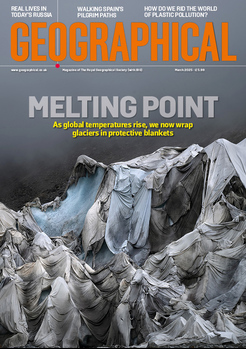
Chris Aslan tells the story of his scheme to help the nomads high in the Pamir Mountains make some much-needed money from the yak down that they previously discarded
Words and photographs by Chris Aslan
I’m breathless. It’s partly because the Pamirs are breathtaking, with sweeping raw vistas of wide glacial valleys and snow-covered peaks, dotted with tiny splashes of colour that represent a cluster of three or four yurts, and bright clothing laid out to dry on the yak-clipped meadow. It’s also because the Pamirs are known as the roof of the world, and at 4,000 metres or higher in altitude, the thin air is literally taking my breath away. Eagle vultures, known locally as bone-crushers, wheel in the sky, occasionally dropping carrion bones onto rocks below to break them open. The main sounds, other than the wind, are the shrill birdlike warning calls of plump honey-coloured marmots sitting near their burrows, and the pig-like grunting of yaks.
We’re driving from Alichur – a village of white-washed flat-roofed mud buildings – to where many of the villagers have headed, given that it’s summer: the jiylo, or summer pasture. ‘Are you okay?’ I check with Stephen, sitting beside me in the driver’s seat. He didn’t sleep well last night and is a little grouchy. Cindy and Beth are happy taking photographs as we stop at a well-known pool, a deep, clear turquoise, with large fish weaving beneath. Beside the pool is a simple mud-brick restaurant that unsurprisingly specialises in fried fish. Next to it is a large mound of teresken, a silvery-grey bush with gnarled stems and roots that are important for anchoring the topsoil in place. During the Soviet years, the region was kept warm by plentiful trucks laden with coal. Since independence, locals have turned to teresken. Due to the high altitude, it grows slowly and a knee-high bush is well over 50 years old. It only takes about 50 seconds to get burning, though, and is being used as a major fuel source for cooking and heating, as we’re high above the tree line and there’s no wood. Later, we would see trucks piled high with teresken, and its usage threatens to turn large parts of the Pamirs into high-altitude desert. Another threat that I learn about later, are cashmere goats. They graze destructively in ways that don’t allow grasses to regrow, unlike yaks, which both graze sustainably and provide yak-dung, which can be dried into bricks and used instead of teresken for fuel.
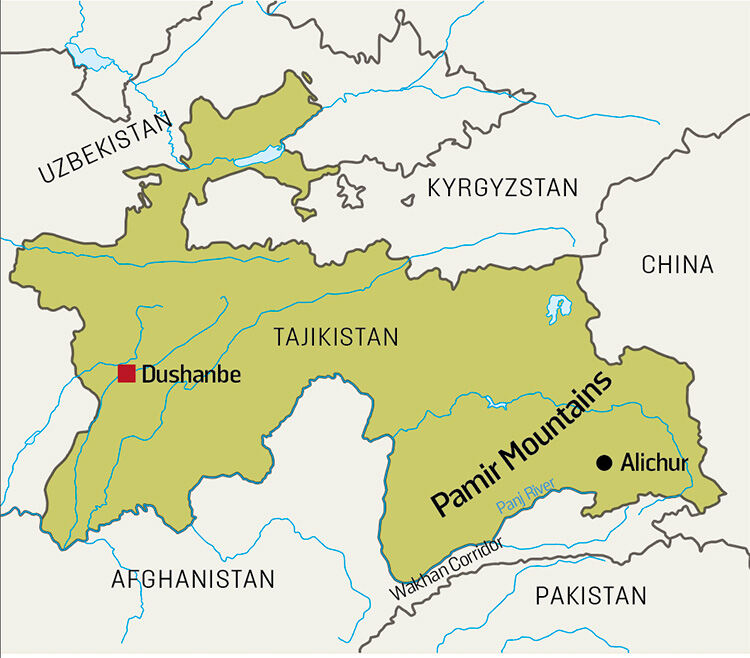
We continue our journey and spot a settlement that we’d been told about in Alichur. This is the summer pasture for some of the residents from there. We pull off the road and drive along a dirt track, with tussocks of grass, streams and bog to one side of us as we near the river. Passing over it, we near the settlement. There are four yurts – two slightly larger than the others – a truck, waist-high stacks of yak-manure bricks and several yak calves, which we dub ‘the yaklets’, tethered in a row and guarded by a shaggy husky. We attract curious glances from some of the residents who come out to meet us.
Although we’re in Tajikistan, this eastern region of the country is a semi-autonomous area that wants independence but won’t get it, and is made up largely of non-Tajik ethnicities. In the deep valleys to the west, on the Afghanistan side of the River Panj, are fair-skinned Badakshani people, made famous by a woman with piercing green eyes on the cover of an issue of National Geographic. The river runs along most of Tajikistan’s southern borders with Afghanistan. In the High Pamirs on the Tajikistan side of the river most people are Kyrgyz.
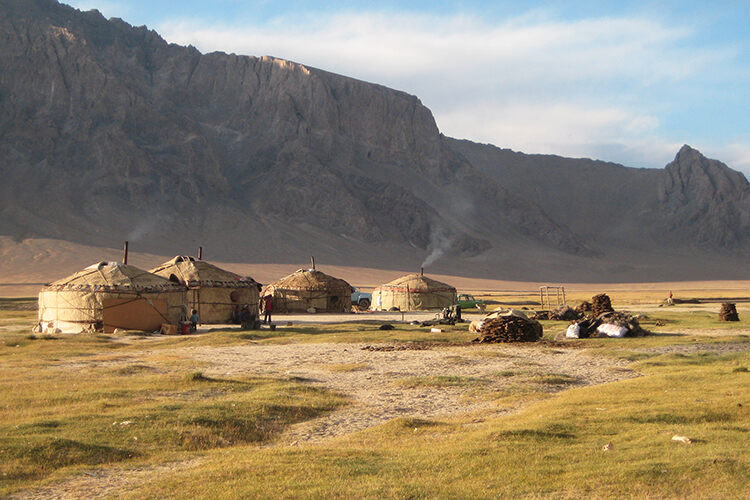
I call out a greeting in my bastardised Kyrgyz and receive beaming smiles of comprehension in response. We’re introduced to the head of the settlement and I’m about to ask if we can rent one of their yurts for a few nights, but he waves away such vulgarities as business, as first we must come in and drink tea and break bread. Only then might we raise our reasons for visiting.
We’re guided to a simple yurt of grey felt, with no outer decoration except the patchwork applique felt rolled up above the wooden door frame and a rim of patchwork squares from above the entrance all the way around. I discover later that patchwork, with its jarring tessellations and abrupt changes in pattern, is considered effective at warding off the evil eye. There are other things I miss about the yurt that I only discover later. The felt entrance covering includes two blue circles of felt that mimic eyes and are supposed to fool the evil eye into passing over the yurt, thinking it has already left its mark. If that doesn’t work, there’s always male sexual potency. For the nomads of Central Asia, male sexual potency is symbolised by ram’s horns. This is perhaps the most common motif in nomadic textiles and leatherwork and has powerful amuletic powers.

We slip off our shoes and enter the yurt. Underfoot are warm applique felts, rich in design and vibrantly coloured. There are also woollen flatweave strips sewn together to make decorative wall rugs that run behind the wooden latticework of the curving wall. A yurt may appear to be one circular room, but it’s zoned. The right side of the yurt is the men’s section, and saddles, tools and ‘men’s tat’ is kept along its circular wall. The left side is for women, and that’s where you’ll find the butter churn and a beautiful reed screen, with each reed wrapped in different-coloured wool to make geometric patterns similar to a kilim (a woven rug). This provides an area behind which people can get changed, wash themselves with a cloth, or store things away when guests turn up unannounced, as we have. The rear wall of the yurt is made up of chests, each stacked with bedding and sleeping mattresses, which can be laid out at night and then stored away during the day.
Our host ushers us to the place of honour, with our backs furthest from the entrance, and we sit around a plastic food cloth on the floor as the wife of our host brings in two rounds of freshly baked bread, puffed golden and similar to Indian naan in consistency. She breaks pieces and places them around the food cloth, adding bowls of yak yoghurt and yak cream, and beckons us to eat. I dip a piece of bread into the cream and my eyes widen at its sweetness. We soon learn that yak dairy is vastly superior to anything that comes from a cow.
The word that the Kyrgyz used to describe their felt homes is ui, which means house. The term yurta doesn’t refer to the structure at all. Instead, it means home. For nomads of Central Asia, their home is in four different locations as they rotate their pasture with each season in a practice known as transhumance. So, for example, when arriving back at their winter pasture, an extended family would see the stone circles that marked out where to set up each felt house, as well as the nearby stream and the graves of ancestors who had finally ceased roaming and now remained in elaborate tombs. This is yurta, or home. When Russians first interacted with the nomads and pointed in the direction of these settlements, asking what they were, the reply was ‘home’ – so the Russians began to refer to the domed houses of wool as yurts, and that’s where we get the term.
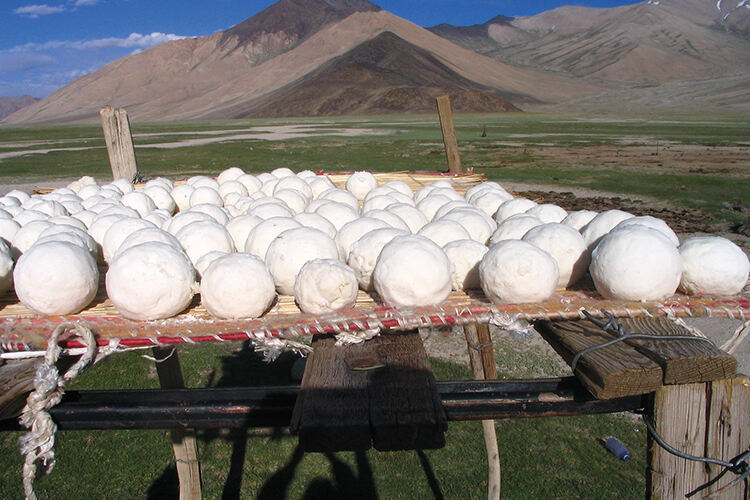
Yurts weren’t only the main dwelling places of the Kyrgyz mountain people, but also the Kazakhs of the steppes, the Karakalpaks of the marshy reed kingdom of the Aral delta, the desert-dwelling Turkmen and the Lakai tribe of Uzbek-speakers who roamed the hills of southern Uzbekistan and northern Afghanistan. In fact, by the end of the 19th century, yurts could be found as far west as Anatolian Turkey, and as far east as the Gobi Desert, stretching a quarter of the way around the world. Despite the vast region across which they’re spread, the nomads all agree that assembling a yurt is a job for women, although many a man is happy to sit and mansplain as the women work. Three women can usually set up a yurt within half an hour. If there’s furniture, this is often placed first and then the yurt assembled around it, as the wooden door frames are too narrow to fit furniture through.
In our yurt, we watch the slanting rays of the late-afternoon sun pour through the open door, as we unpack and make ourselves at home. Our hosts have moved out so we can have this one to ourselves. We hear the yak calves, still just a month or two old, begin a frantic commotion and poke our heads out to see what’s happening. The herd is returning from grazing and the calves cry to their mothers, which answer not with lowing or mooing, but with pig-like grunts. Most of the yaks are chocolate brown, but some are golden caramel, striking slate-blue, or piebald. The yak calves are allowed to suckle, but they’re made to share. One of the women pulls up a simple stool, nudges the yak calf out of the way and begins to milk.
Some of the fresh milk is poured into a separator. I don’t fully understand the mechanics of this Soviet-era contraption, but a crank is turned and the milk that’s poured into a funnel emerges later either as buttermilk, flowing into one bucket, or thick cream flecked with butter, flowing into another. Some of the buttermilk is used for drinking or making yogurt, but most is kept until the following day and then poured into a large metal vat over a smouldering fire of dry yak-dung bricks. Once warmed, a little vinegar is added to curdle the mixture and then the whey is drained off. The curds are mixed with salt and then poured into plastic rice sacks hung up on a wooden platform, which act as sieves, allowing more whey to drain away. After a day or so, the remaining sludge will be rolled into large balls about the size of a mozzarella cheese. These curd balls are placed on a high platform, out of reach of huskies and rats, where they dry in the sun and wind. They’re then stored for winter consumption, when they will be crumbled into black tea with a dollop of yak butter, into which bread is dipped. This will do for two or even three meals a day. While milking, I notice the winter coat flaking off the flanks of some of the yaks. Some have moulted entirely. It must be incredibly warm as the yaks can survive very cold winter temperatures. When the women have finished milking, I ask if they can obtain some of it for me. I want to find out more about this yak wool or fur or whatever it is. ‘What do you use it for?’ I ask. One of the women shrugs, ‘For making felt if a couple is getting married and needs a new yurt. Otherwise, the wind just takes it.’

I tell them that I would be happy to pay them for a few bags. They need no further motivation and soon we’re helping lasso yaks and fill plastic bags as the sun sets.
During the night, I have to go outside to pee and get distracted by the stars. The high-altitude air is so thin that the Milky Way – or Star Path, as it’s sometimes referred to locally – is lit up above me, and I end up staying outside for far too long. One of the huskies comes and curls at my feet as I stare upwards. They’re never allowed inside a yurt. Finally, I’m driven in by the cold, my teeth chattering. The stove crackles a little as the dried yak-dung bricks smoulder inside, and it’s markedly warmer than outside. It feels very different from the flimsiness of a tent. This is truly a house, just one made from wool.
I pass the yak samples on to an American textile artist based in Tajikistan’s capital, Dushanbe, and she spins it for me. In the meantime, I try to learn more about yaks. I discover that like most ruminants in colder climes, they have two coats – an outer shaggy coat of hair that anchors in place a fine undercoat of down. The fibres aren’t as long as those in sheep’s wool, and they’re beautifully soft, unless you spin the fibre and hair together.
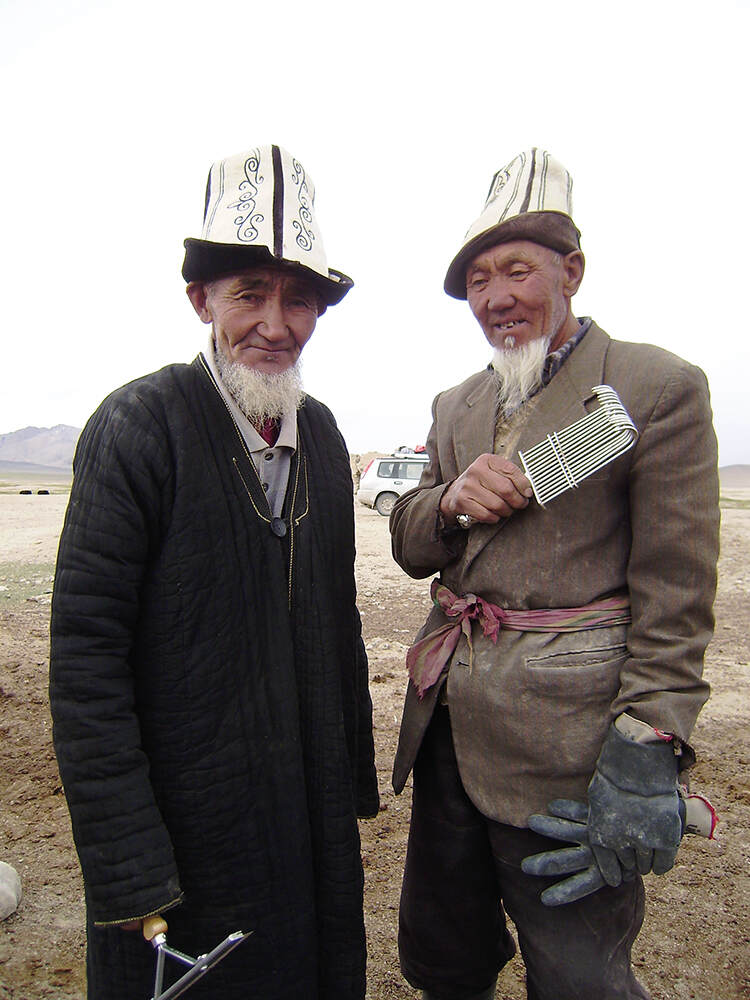
‘As you can see,’ Karen, the artist/spinner, explains, ‘it’s wonderfully soft, but it’s also really scratchy because of the hair content. Let’s just say, you wouldn’t want underwear made with this. If you could find a way to separate the down from the hair, then it’s almost cashmere.’
Almost cashmere, and yet this yak down is largely being taken by the wind, and yak herders struggle to make ends meet. I resolve to start a project that does something with this incredible fibre, but first, I need to learn how to get the down from a yak, and not end up with loads of rough hair. The following May, I return to the Pamirs. Although it’s already sweltering in Dushanbe, up at this altitude, winter has barely finished and there are still patches of snow and ice on the ground. The yaks look gaunt, and so do the Kyrgyz. It’s a far cry from the bucolic summer I’d seen before. Yak herders vary in their reactions to our proposed project; some are initially sceptical about whether anyone will actually purchase this waste product. Others are incredulous: ‘We’ve been herding yaks for centuries. Why has no-one told us until now that we’re throwing away something so valuable?’
Since the previous summer, I’d tried to learn more about yak down. Yaks live at altitudes of between 2,000 and 5,000 metres, with 90 per cent of the world population in China and Tibet. Their down is considered one of the lightest, warmest fibres in the world, being three times warmer than sheep wool, and yet it was only harvested commercially from the 1970s. It’s still often passed off as cashmere. In fact, if you own a cashmere jumper that was made in China, chances are that it’s been blended with yak down, which still doesn’t seem to sell so well in its own right. What do you even call it? Yakshmere?

Our trip the previous summer had been at the end of the moulting season and the yak down had simply flaked off in clumps. Now, along with the yak herders, we’re having to tug the down off the flanks of the yaks, often leaving patches that look raw and painful. Sarah, an engineering student from Cambridge, joins us, having made our technical challenges of down collection and processing the subject of her dissertation. She agrees that harvesting by this method is both cruel and ineffective. After graduating, Sarah joins the project and the following year we make a much longer trip up to the High Pamirs to trial three different styles of cashmere combs to see which one works best on yaks. The first comb is pretty and ornate and comes from Kashmir. It proves utterly useless, so we stop bothering with it after the first day. The second type are from the USA and look a bit like miniature rakes with nice wooden handles. They’re okay, but not great. By far the best combs are the ugly, hand-soldered, metal-hooked wire ones from Mongolia.
Our main aim for the five-week trip is to visit as many settlements as possible throughout the High Pamir plateau and show herders how to use the combs, spreading the word. Then, the following spring, we’ll return with more combs and distribute them so that herders can harvest their own down, which we will buy from them. Yearling yaks produce the highest yield of down, with a 70 per cent ratio of down to hair, while a six-year-old mature yak only produces 20 per cent down to hair. With adult yaks, the best down comes from the neck area and just under the long, hairy mane that follows a yak’s spine. Yaks don’t like being combed, so we become adept at hobbling them. This requires grabbing a yak by the horns and giving its neck a sharp twist of 45°, then tying the downward-facing horn to a front leg, which disorientates and immobilises the animal.

On the whole, yaks are good-tempered and tend to be shy of humans. There are exceptions. The first time I see a newborn yaklet, still glistening and wet, its legs all wobbly, I kneel on one knee, a little too close, to take a photograph. The mother, hovering nearby, becomes agitated, but I’m oblivious to this until she charges me. Her horn takes me in the groin, just missing my genitals and leaving me with a large, vividly blue bruise along my inner thigh. I tumble face first into dried yak dung and break my glasses.
A constant challenge is washing and staying clean. Aluminium ewers (wide-mouthed jugs) and decorative basins are usually available in the yurts where we stay, although they’re designed for hand washing rather than something more all-over. I learn to squat behind the reed screen in each yurt and attempt a flannel bath to clean the essentials, but the only public bathhouses are hours away in the nearest town of Murghab, so we mainly rely on the region’s numerous hot springs. Sometimes these are open-air and scarcely more than warm puddles, but no less a welcome sight.
My favourite hot spring is just above the tip of the Wakhan Corridor. Due to its proximity to the border with Afghanistan (if you can call a long fence of barbed wire that the local villagers roll back each morning to let their yaks graze where they want a border) there’s an army barracks next to the spring, which the soldiers inside consider theirs, and we must ask permission before using it. We dutifully do so, and soon Victor and I are wallowing in bubbling hot water like a natural jacuzzi, surrounded by snow-capped peaks. It’s hard to drag ourselves away. We cross the river and spend a day or so teaching a border village how to comb their yaks before returning. We assume that, having previously asked for permission to use the spring, we’re still covered, and Sarah uses it first. Then it’s our turn, and I’m desperate to wash my hair. I’ve barely lathered up when two soldiers stalk over to us, guns slung over their shoulders, demanding to know why we’re trespassing and ordering us out. I assure them that we already requested permission.

‘That was for before, not now,’ one of them barks at me. ‘Okay,’ I reply, ‘Once we’re finished, I’ll go and speak to your commander and apologise for the miscommunication.’
‘No, you must get out now,’ demands the more annoying of the two, who then pointed his weapon at us.
‘Okay, okay,’ says Vic, holding up his hands and trying to calm soldier boy down. I’m getting peeved. ‘No,’ I reply. ‘I’m going to wash my hair. It’ll only take five minutes, and then I’ll go and see your commander.’
Gun Boy (as we christen him) cocks his gun and points it at me, glowering. ‘Go for it,’ I tell him. ‘Then explain to your commander why you shot a foreign guest and got his hot spring all bloody.’
I duck under the water and gave my hair a quick scrub, but when I come back up, Victor gives me a look and I concede defeat and climb out with as much dignity as I can while naked with a gun pointed at me.
‘Is this how Tajiks treat guests in their country?’ I hiss at Gun Boy as I towel off. He looks a little chastened. Hospitality in Central Asia is practically sacred.
We’re march to our vehicle, the roof rack towering with bags full of yak down and some ibex horns that Vic has found and wants to keep. It’s a fairly new four-wheel drive, but with low clearance that’s woefully inadequate for our off-road-driving needs.
We drive off down the main track but then attempt a shortcut off-road. This is a mistake and we soon find ourselves stuck in mud. We place boards under the tyres, as this isn’t the first time this has happened, but to no avail. Eventually, I realise that we need help and walk back to the army barracks. Sheepishly, I explain the situation, and they’re quick to help us, even Gun Boy. Armed with spades, we eventually shift the vehicle onto firmer ground, and by then, Gun Boy and I have become friends and have our photo taken together.

Having tested the various combs, I’m tasked with finding a metal workshop in Dushanbe that can make us several hundred more. Our plan is to scale up the following spring. Meanwhile, we’ve tried to find simpler technology to de-hair the yak down, but to no avail. Sarah’s father is Chinese and is helping us explore the possibility of importing a whole de-hairing facility from China. First, though, we travel up to the High Pamirs in April, which is still winter, and travel around the villages and settlements giving seminars on how to get down from their yaks, and the importance of a high down-to-hair ratio. We also distribute combs and contracts and there’s a buzz about the project. However, I get a call that puts an end to it all. It’s my boss calling from Dushanbe and she’s almost in tears and obviously shaken. ‘I’ve had the authorities in my office, and they are making wild accusations about you, including that you’re a Swiss spy.’ I’m baffled, not least because, if they’re going to make me a spy, then why not a British one? We realise they must have mixed Switzerland and Sweden up, as the NGO I work for has its headquarters in Sweden. I have a month to leave the country or the government will take our organisation to court.
We fight the decision, handing in character references, and getting embassies involved, but nothing works, and soon I’m on a plane to the UK. I’m hoping the project will continue without me, but as the only person who speaks Pamiri and Kyrgyz, that proves optimistic, and a few months later, it’s shut down.
I feel terrible for all the poverty-stricken families whose hopes we’ve raised and will now be disappointed. They have the combs, however, and maybe, now that they know how to get down from a yak, they’ll be able to sell the down to Chinese traders. For me, I’ll never forget the starkly beautiful landscape, nor the few Kyrgyz who are still semi-nomadic, despite Stalin’s attempt to forcibly settle them and the allure of urban living, nor the yaks from which I’ve got down. l

